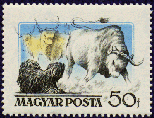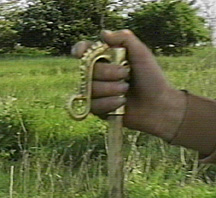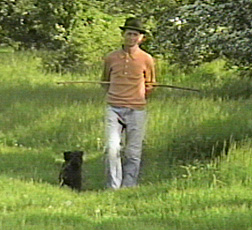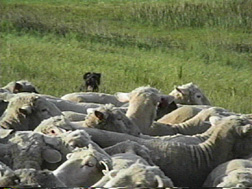|

THE HERDING PULI
The Puli is a vigorous bouncing vocal herder. His job is to move 300 to 400 sheep (most with foot rot) in tall grass. He bounces so he can see over the grass. He barks because he must move a large sluggish mass of sheep which don't want to move. This is the real world. The herding 'show ring' of the AKC Herding Trial is not the real world.
CH. Szeder's Making Headlines, CD, HI, HX, AX, OAJ is the first Puli to complete the AKC requirements Herding Intermediate and Herding excellent. She is also a Herding High in Trial.
The Puli and his herding style today is a reflection of selection based
on the demands of his work and environment. In Hungary, historically and
to this day, the Puli is in charge of flocks numbering 300 to 400 sheep.
This size of these flocks demands that the Puli be a forceful, vocal, close
working herder. And he is. The AKC wants us to exhibit a dog which works
well back, and quietly. The Puli can learn this, but it is not what he
is meant for. Much of the Puliís personality and approach to life are a
result of the demands of such large flocks. His impatient and sometimes
vocal response are a result of his frustration with us for not providing
him with a suitable arena to work. The demands of AKC trials are simply
that and no more; they are not a suitable comment on the breedís ability
to perform useful work in his own environment.

Pulik are represented in AKC trials, though as a relatively rare breed,
they do not participate in the numbers of some of the more common breeds.
Ch. Szederís Go For It, HS is pictured doing Agility on the Other Resources
page; Pete has two Reserve High inTrials. His half sister, Szederís Making
Headlines, HX, CD is the first Puli High In Trial (herding), and the first
Herding Intermediate and Excellent for the breed.
The skills of the Puli, when in his own environment, include the ability
to instantly lift an entire large flock, and to turn it, if not on a dime,
then certainly on a quarter. Once on the move, he will join his shepherd
at the rear of the flock to drive. While grazing, the flock is observed
from a place where his shepherd may also be observed, or can be kept
in his peripheral vision while he is at play, if a companion is available.
This is not your average Border Collie, folks. A gesture from the shepherd
will send him off to zip around the flock to tighten it up or turn it,
then back to taking it easy until the flock needs more attention.

Morzsi and Jozsef at Mesofalva
I cannot be clear enough about the power required of a dog under these
circumstances actually encountered in Hungary. One of the working dogs
I have seen there was working with a flock at least 50% of which had hoof
rot, in tall wetland grass on a hot afternoon. These animals understandably
did not wish to move, but did, and exhibited the ability cited above -
to turn on a "quarter". I donít know how many individuals of
some other breeds would have required to elicit this response. I suspect
that any number of some breeds couldnít do it at all. So please
letís not sell the Puli short due to a misunderstanding of what his job
really is.

PULI CLUB OF AMERICA
PULI HERDING DESCRIPTION
Approved by the Puli Club of America April 1992
Introduction: The Puli was developed in Hungary as an all purpose
herding dog, bred to gather and drive the flock as the shepherd commanded.
He can work and control all types of stock, but was developed particularly
for sheep. The Puliís power lies in his bouncy, active movements, and occasional
high pitched yelp that starts the stock moving. The Puli is a loose-eyed
dog and rarely grips or bites except as a last resort.
Historically: Flocks were kept on huge pastures and vast plains.
Pulik gathered the stock from the villages and drove them from one area
to another to graze. This often involved moving the stock for miles along
the roads and by crops. Driving the stock to market from the grazing lands
meant the dog often worked a full, hard day. The Puli was developed as
a medium-boned, wiry, agile dog with a thick protective all weather coat,
often of black color to enable him to be easily distinguised from the sheep.
Shepherd/Puli Relationship: The relationship between shepherd
and Puli is fundamental to understanding how the breed herds. There was
an unwritten law that a Hungarian shepherd did not sell a Puli to anyone
other than another shepherd or as a gift to a family member. The shepherd
felt that non-pastoral people would not understand the Puli temperment
and intelligence. To the shepherd the Puli was more than "just a dog";
he was the flockís "second man". The Puli serves as a constantly
alert foot dog for the shepherd. When the sheep are grazing he is at the
shepherdís side. When commanded verbally or by gestures from the shepherd,
he responds with a tremendous burst of speed and activity, forcing movement
of the stock away from him by his bouncy, bounding manner. Then he returns
to the shepherd to await the next order. Although clearly subordinate to
the shepherd, the Puli is expected to work on his own initiative. A Puli
who is familiar with the order of things will hasten to correct even a
complex problem without a command. The Puliís bouyant, self-confident and
joyous enthusiastic working style can be very effectively turned off by
inappropriate training. This occurs when attempts are made to make the
very sensitive Puli work in a manner not natural to him, such as insisting
that he work in a highly precise manner, as is done with some other sheepdog
breeds and/or by making excessive corrections during training. When this
happens, frustration sets in for all and the Puli can lose his self confidence
and with it his desire to herd.
Training: Upon the Puliís first exposure to stock, he often shows
a definite gathering instinct. In Hungary, the Puli grows up with stock
and learns all about them at a very early age. He receives on-the-job training
with the experienced dogs and he gradually learns to drive the stock from
the farm and down the lanes to the grazing lands or from pasture to pasture
while keeping the flock loosely gathered. The Puli is one of the most intelligent
breeds of dogs. He is a willing worker and can be trained easily to follow
commands and directions. In this country, the ideal situation would be
to have the novice Puli start working with the more experienced Puli as
they did in Hungary. Care must be taken, however, that the younger dog
does not get overly accustomed to acting in an assistantís role, thus reducing
his ultimate task, that of learning to carry responsibility for the care
of the flock. This trainability combined with the Puliís natural urge to
gather and move the stock make the Puli an ideal herding dog.
Herding Style:
1) The Puli has a strong desire to please his master. He works
in harmony with him and is usually at his side. He does not work away from
the shepherd unless performing a task. After responding with his characteristic
lightning speed, he returns to his shepherd. While at the shepherdís side
he may be standing, sitting, or lying down, but he is always alert.
2) The Puli does not use "eye" to control the stock but
rather he utilizes his natural bouncy, erergetic, quick, feinting movements
and the occasional high pitched bark.
3) The Puliís approach to the stock is usually close running but
may be widened through training. The Puli works close to the stock, often
stopping and turning them with his body.
4) The Puli is fully capable of moving and gathering the stock as
directed by his shepherd. The Puli does not work with the intensity of
some of the other breeds and this looseness of style is natural for this
breed.
5) The Puli who is with his flock attends only to his shepherd and
will remain aloof from the casual human bystander. The Puli will pretect
his shepherd and the flock from predators and strangers even if it means
his death. This was the unfortunate fate af many Pulik during World War
II.
Applications To Testing: The Puli works from his shepherdís side.
Typically he is not in constant motion patroling the flock. The Puli will
not naturally patrol a boundary, but can easily learn to guard a boundary
from a position near the shepherd.
The Puli should not be faulted for returning to his masterís side after
completing a task. The Puli runs rapidly towards the livestock. Sheep worked
by other breeds may at first find the Puliís speed upsetting.
Summary: Lest we forget the Puli was developed by and is still
used by very practical men. Men who most likely did not (and do not) have
the time, patience or desire to spend endless valuable working hours going
over and over practice exercises with a dog in order to teach it how to
work with the mechanical precision seen demonstrated in many of the herding
trials today. They depended on the Puliís intelligence to enable the dog
to pick up and learn from the older Puli. The men who developed the Puli
could not afford to feed a dog who did not work. A dog who could not measure
up within a reasonable time was disposed of. Whether from a lack of mental
or physical abilities, "weak" dogs were thus eliminated from
the gene pool. In either case, with neither the competition of the breed
ring nor the organized herding trial to goad him on, the practical shepherd
sought only to produce a practical dog for his own personal use. The Puli
has stood the test of time. He was then as he is today, a practical dog
for the average farmer or rancher to work with, to treasure and to brag
about when he takes the stock to market.
|



